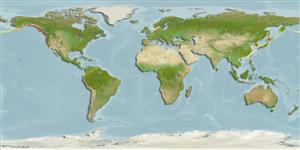Common names from other countries
Classification / Names / Names
Namen | Synonyme | Catalog of Fishes (gen., sp.) | ITIS | CoL | WoRMS
Environment: milieu / climate zone / depth range / distribution range
Ökologie
; tiefenbereich 0 - 28 m (Ref. 865). Temperate
Pacific Ocean. Subtropical to boreal.
Length at first maturity / Size / Gewicht / Alter
Maturity: Lm ? range ? - ? cm Max length : 18.0 cm TL Männchen/unbestimmt; (Ref. 822); common length : 4.0 cm TL Männchen/unbestimmt; (Ref. 822)
Assumed maximum and common length from Ref. 822. Feeds on crustaceans, prosobranchs, tunicates, sponges and bryozoans. Predator: polycerid nudibranch and the sea tiger (Ref. 844).
Life cycle and mating behavior
Geschlechtsreife | Fortpflanzung | Ablaichen | Eier | Fecundity | Larven
Members of the order Nudibranchia are simultaneous hermaphrodites. Mating behavior: Both individuals darts their penis toward each other to induce one to act as a male and the other as the female. The victorious one to penetrate the body wall is the dominant male. Life cycle: Eggs are deposited on a substratum where they develop and hatch into (planktonic) vestigial veliger larval stage and further grow as adults.
Debelius, H. 2001. (Ref. 844)
IUCN Rote Liste Status (Ref. 130435)
CITES Status (Ref. 108899)
Not Evaluated
Not Evaluated
Nutzung durch Menschen
| FishSource |
Tools
Mehr Information
Alter/Größe
Wachstum
Länge-Gewicht
Länge-Länge
Morphologie
Larven
Dichte
Internet Quellen
Estimates based on models
Preferred temperature
(Ref.
115969): 7.6 - 17.9, mean 10.7 (based on 569 cells).
Verwundbarkeit
Low vulnerability (10 of 100).
Preiskategorie
Unknown.
